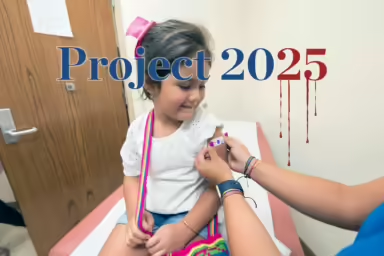Posturing and messaging aside, the timing of Washington’s move to end the COVID-19 emergency is greatly at odds with the reality of the ongoing global pandemic.
|
Listen To This Story
|
On March 29 the Senate passed with bipartisan support a bill to end the emergency status of the COVID-19 pandemic, joining the House, which passed similar legislation at the end of January. President Joe Biden says he strongly opposes the bill but his administration nonetheless plans to let the emergency status expire on May 11.
Not surprisingly, given the politicization and political weaponization that has characterized the COVID-19 crisis from its beginning, much of this activity in Washington comes down to symbolism and posturing. And indeed, as Rep. Jim McGovern (D-MA) put it: “There’s a right way to wind down. … This is about messaging.”
Posturing and messaging aside, the timing of this move to “wind down” the emergency is greatly at odds with the reality of the ongoing global pandemic.
There have been, to be sure, a reduced number of reported COVID-19 deaths. So far this year has averaged fewer than 4,000 deaths per week, compared to an average of over 5,000 deaths per week for 2022. In 2020 and 2021 respectively, more than 350,000 and 475,000 Americans died from Covid (this was enough to place Covid as the third leading cause of death, with heart disease and cancer each claiming over 600,000 Americans per year). That’s approximately 6,700 per week in 2020 and 9,000 per week in 2021.
So weekly death totals have dropped significantly from the worst of the pandemic. While one problem with this comparison is there is now far less testing and reporting of deaths to the Centers for Disease Control and Prevention, those are nevertheless the official numbers and they are down.
But deaths, while still attention-grabbing at the thousands-per-week scale, don’t tell the entirety of the story and obscure another serious aspect of this ongoing crisis: long COVID, a debilitating post-infection, multisystem condition with common symptoms of fatigue, shortness of breath, and cognitive dysfunction, impairing the ability to perform daily activities for a period ranging from months to years.
It was only in August of last year that the US set up a National Research Action Plan and allocated $1 billion to long COVID recovery. While the “better late than never” truism might apply, waiting over two years to begin addressing a mass disabling event is sadly reminiscent of our slow response to the HIV crisis.
Because of the lack of knowledge and treatments for long COVID, doctors recommend focusing on prevention. This is unfortunately at odds with the agenda of many political leaders, who want to “move on” from the crisis and its attendant masking and isolation policies.
Fifteen percent of American adults, or nearly 40 million of us, have reported having long COVID. Currently it is believed that each COVID-19 infection brings a 5 percent chance of developing into long COVID. Reinfections, which can do cumulative damage to organs like the brain and heart, also factor into susceptibility to long COVID.
“You may get long COVID the second time around, the third time around. That reinfection is absolutely consequential, and you’re pretty much doing Russian roulette again,” said Dr. Ziyad Al-Aly, chief of research and development at the Veterans Affairs St. Louis Health Care System and a clinical epidemiologist at Washington University in St. Louis.
Current research establishes that 79 percent of people with long COVID have to limit their daily activities. Al-Aly describes some long COVID patients this way: “Some of [these patients] literally cannot even read an email. They have brain fog that is so profound, it substantially impairs their cognitive abilities.”
An editorial from The Lancet confirms that the global problem persists:
Without specific treatments for long COVID, attention needs to fall on prevention — keeping COVID-19 cases low and ensuring vaccination — and patient-centered multidisciplinary care. Patients, many with complex multimorbidities, need multisectoral physical, cognitive, social, and occupational support.
An NBC News report detailed new studies that have determined that the immune response to COVID-19 damages the way calcium is stored and channeled through the body:
The damage caused by inflammation during a COVID infection appears to prop these channels open, letting too much calcium leak from the cells of the heart, said Dr. Andrew Marks, a cardiologist and biophysics professor at Columbia University, who co-led one study. This flood of calcium, he said, can decrease heart function and even cause fatal arrhythmias, or irregular heartbeats.
This same damage to calcium ion channels is found in the brains of some people infected with COVID-19. And it is a type of damage to the brain also found in people with Alzheimer’s. The brain fog and potential long-term effects on the brain are among the most terrifying aspects of long COVID. In real life there is no Wizard of Oz to hand out new ones — or hearts either, for that matter.
There is some good news. The effects on the brain and heart can heal, though it may take up to a year. Also there is evidence that vaccination, even partial vaccination, can reduce the likeliness of heart attacks and strokes from COVID-19 infection.

Because of the lack of knowledge and treatments for long COVID, doctors recommend focusing on prevention. This is unfortunately at odds with the agenda of many political leaders, who want to “move on” from the crisis and its attendant masking and isolation policies.
Even left-leaning media such as The Atlantic, have been conveying this message. A May 2021 article that has aged like unrefrigerated milk featured this quote:
Even as scientific knowledge of COVID-19 has increased, some progressives have continued to embrace policies and behaviors that aren’t supported by evidence, such as banning access to playgrounds, closing beaches, and refusing to reopen schools for in-person learning.
May 2021 was not quite halfway through a year that would end with 450,000 COVID-19 deaths and, as we’ve discovered, long COVID in nearly one-fifth of all adults in the United States.
As America prepares to declare the emergency over and done, COVID-19 continues to cut a swath through the rest of an interconnected world. India reported an increase of nearly 4,000 cases in 24 hours on April 2. In England, COVID-19 levels reached a high for 2023, prompting a new round of vaccination. In a strange contrast of policies, the British test-and-trace program is being phased out just as the new round of vaccines is being administered.
China has said that 80 percent of its population has contracted COVID-19 since it lifted its draconian lockdown policies in response to swelling public unrest. The policies had been brutally enforced and very unpopular, but were highly effective at restricting the transmission of the virus between communities. After the lockdown was lifted at the end of 2022 the virus romped through China.
Yet China has released an official death count of only 83,150. This is strongly contradicted by evidence acquired by sources outside China, with 60,000 deaths in the space of five weeks from December 2022 to January 2023 as the lockdowns were abolished. Based on the US mortality rate per infection, as well as evidence obtained from sources besides those cited by the Chinese government, estimates are roughly 1.5 million mortalities.
 Less headline grabbing is the simple math that if 80 percent of China’s population of 1.4 billion have been infected, as Chinese officials claim, then those billion-plus cases provide more than a billion new chances for mutation and variants. Also, if the ratios reported in the US apply, those infections are likely to produce over 100 million cases of long COVID in China, disabling at least 10 percent of the adult population — and that is not accounting for reinfections.
Less headline grabbing is the simple math that if 80 percent of China’s population of 1.4 billion have been infected, as Chinese officials claim, then those billion-plus cases provide more than a billion new chances for mutation and variants. Also, if the ratios reported in the US apply, those infections are likely to produce over 100 million cases of long COVID in China, disabling at least 10 percent of the adult population — and that is not accounting for reinfections.
There is an old saw regarding US military misadventures: “Declare victory and go home.” We may have declared victory over COVID-19 but, unlike a military adventure overseas, we can’t get away from it by going home. It is here, as is the long COVID epidemic, a mass disabling event that we have barely begun to study and have little idea how to treat.
Doug Ecks is a lawyer and writer. He holds a Juris Doctorate from University of California, Hastings (2010, magna cum laude) and a B.A. in philosophy from California State University, Long Beach, Phi Beta Kappa. He also writes and performs comedy as Doug X.
WhoWhatWhy values our readers’ input and encourages you to drop us a note with your thoughts on this article at MyView@whowhatwhy.org. Your note will not be publicly displayed.




